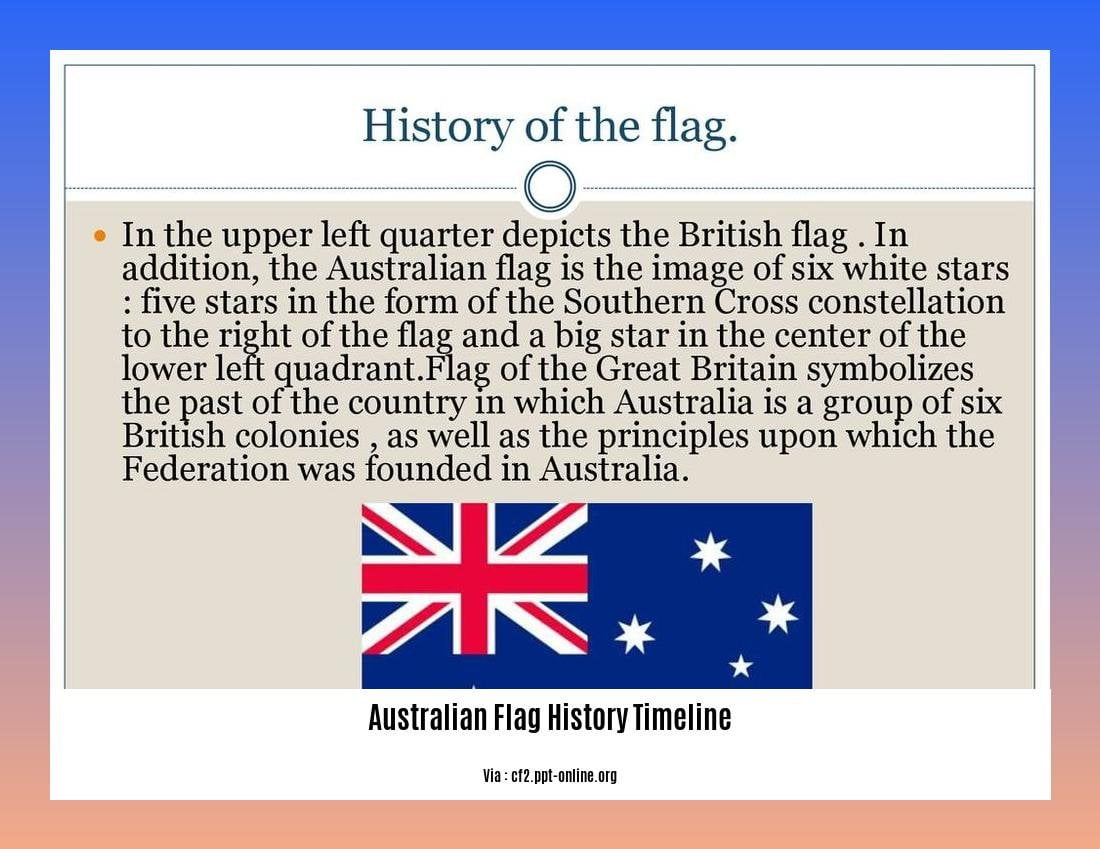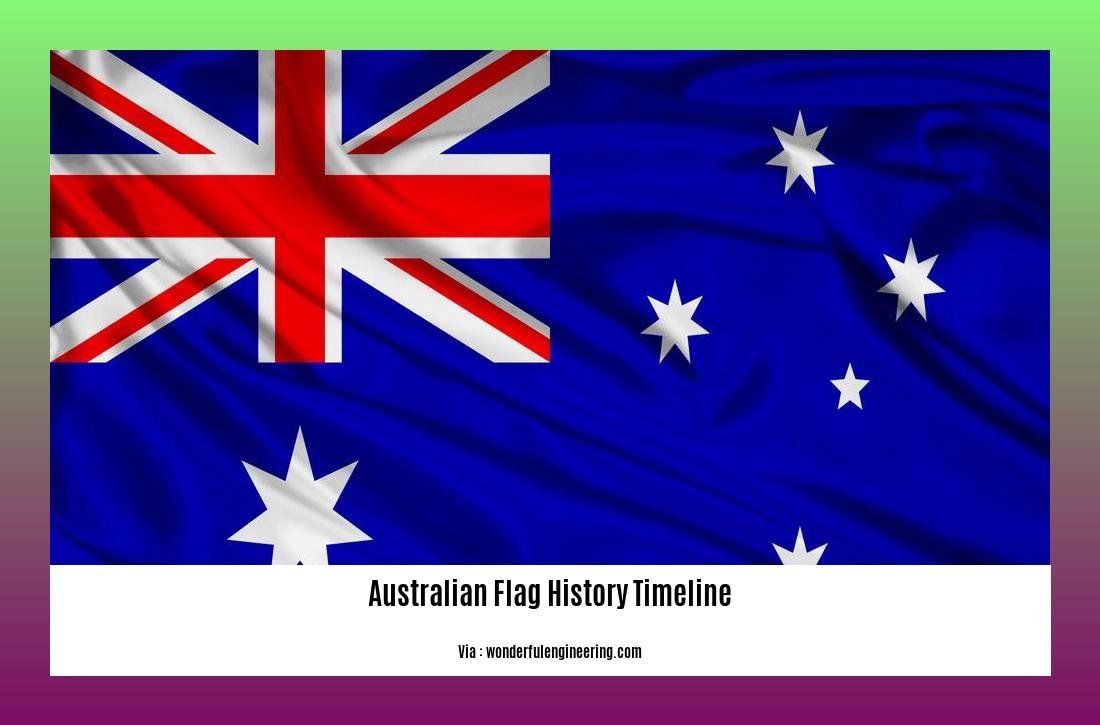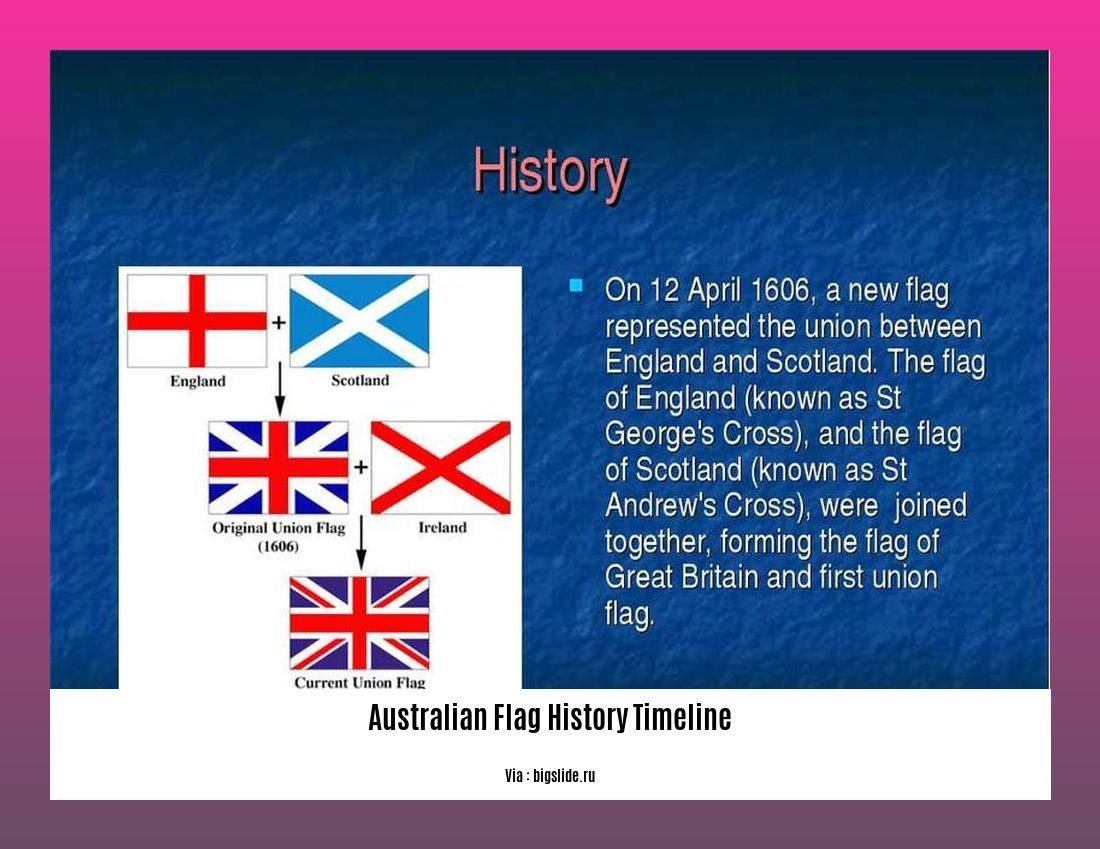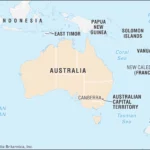Embark on a captivating journey through Australia’s beloved emblem as we unfold the fascinating history timeline of the Australian flag. From its humble beginnings to its symbolic significance in the nation’s identity, this article delves into the evolution of the Australian flag and the socio-political circumstances that shaped it. Join us as we explore the intricate tapestry of Australia’s flag history, offering an in-depth exploration that will enlighten and engage readers.
Key Takeaways:
- The current version of the Australian flag, featuring the seven-pointed Commonwealth Star, was introduced in 1908.
- The dimensions of the flag were formally established in 1934.
- In 1954, the flag was officially recognized and legally defined as the Australian National Flag.
- In 1967, a personal flag for Australia was approved for Her Majesty The Queen.
- The Australian white ensign became the flag of the Royal Australian Navy in 1971.
- The Australian Aboriginal Flag was first raised in 1975.
- The Tasmanian flag was gazetted in 1978.
- The Northern Territory flag was adopted in 1980.
Sources:
[^1^]: Australian Flags Booklet | PM&C
[^2^]: Flag of Australia – Wikipedia
Australian Flag History Timeline

The history of the Australian flag is a captivating journey that reflects the nation’s rich heritage and evolving identity. From its earliest iterations to its current design, the flag has undergone numerous changes, each influenced by significant socio-political circumstances. Let’s dive into the timeline and unravel the fascinating story behind Australia’s beloved emblem.
1908: The Introduction of the Commonwealth Star
The Australian flag, as we know it today, began to take shape in 1908. This marked the introduction of the current seven-pointed Commonwealth Star version of the flag. The Commonwealth Star represents the six states and territories of Australia, with the seventh point representing all future territories. It was a symbol of national unity and shared aspirations.
1934: The Formal Gazetting of Flag Dimensions
In 1934, the dimensions of the Australian flag were formally gazetted. This step ensured uniformity and consistency in the flag’s appearance. The dimensions, including the length and width ratios, were established to maintain the flag’s proper proportions.
1954: Recognition as the National Flag
The Australian flag gained official recognition and legal definition in 1954 through the Flags Act 1953. This legislation solidified the flag’s status as the Australian National Flag and reinforced its significance as a powerful national symbol. It symbolizes the ideals of unity, pride, and democracy that are intrinsic to the Australian identity.
1967: The Queen’s Personal Flag for Australia
An important milestone in the flag’s timeline came in 1967, when Her Majesty The Queen’s personal flag for Australia was approved. This distinctive flag represents the monarch’s connection to Australia, highlighting the historical ties between the nation and the British monarchy.
1971: Adoption of the Australian White Ensign
1971 saw the adoption of the Australian white ensign as the flag of the Royal Australian Navy. This flag features the Union Jack in the canton, symbolizing Australia’s historical association with Britain, and a white field with a red Commonwealth Star and the Southern Cross constellation, representing Australia’s geographical location.
1975: The Rise of the Australian Aboriginal Flag
A significant moment in Australia’s flag history timeline occurred in 1975 when the Australian Aboriginal Flag was first raised. Designed by Harold Thomas, an Indigenous artist, this flag holds deep cultural and symbolic meaning for Aboriginal and Torres Strait Islander peoples. Its bold black, red, and yellow colors represent their identity, history, and ongoing struggle for recognition and equality.
1978: The Gazetting of the Tasmanian Flag
The year 1978 marked the gazetting of the Tasmanian flag. Symbolizing the state’s unique identity and history, this flag features a red field with a white disc containing a modified version of the Tasmanian state badge—a red lion on a white disc.
1980: The Adoption of the Northern Territory Flag
In 1980, the Northern Territory flag was adopted. It showcases a black vertical band running through the middle, representing the Indigenous population, with a white Southern Cross and a Sturt’s Desert Rose—a floral emblem of the Territory—on a blue field. This flag embodies the distinctive character and cultural diversity of the Northern Territory.
As we explore the Australian flag history timeline, we witness the evolution of a nation. Each change and addition reflects significant historical moments, societal shifts, and the commitment to inclusivity and recognition. The Australian flag carries the stories and aspirations of the nation, serving as a source of unity and pride for all who call Australia home.
Here are some active internal links for you:
Atlantic Canada Careers: Looking for exciting job opportunities in Atlantic Canada? Click here to explore the diverse range of careers available in this scenic region.
Atlantic Ocean Fish List: Dive into the fascinating world of marine life with our comprehensive list of fish species found in the Atlantic Ocean. Join us on an underwater adventure by clicking here.
Australian Flag History Facts: Discover the captivating history and intriguing facts behind the Australian flag. Uncover the significance of its symbols and their representation by clicking here.
The Colonial Era: Flags of the Australian Colonies
Key Takeaways:
– The National Colonial Flag, designed by Captain John Bingle and Captain John Nicholson in the early 19th century, is considered the first recorded attempt to design a national flag for Australia.
– The Australasian Anti-Transportation League had its own flag, which was flown at the League’s first meeting in Melbourne.
– The Murray River Flag, an unofficial flag, was flown on paddle-steamers involved in the Murray River trade in the mid-19th century.
– The Eureka flag, associated with the Eureka Rebellion of 1854, became a symbol of rebellion and democracy in Australia.
In early Australian history, several flags played a significant role in shaping the country’s identity and national symbols. These flags represented different historical events and movements during the colonial era.
One of the earliest recorded attempts to design a national flag for Australia was the National Colonial Flag. Created by Captain John Bingle and Captain John Nicholson in the early 19th century, this flag featured the Southern Cross and the Union Jack in combination. It was inspired by the White Ensign of the Royal Navy, reflecting Australia’s connection to Britain.
The Australasian Anti-Transportation League, formed to protest against the transportation of convicts from Britain to Australia and New Zealand, had its own flag. This flag was flown proudly at the League’s first meeting in Melbourne, symbolizing the league’s mission and determination.
During the mid-19th century, the Murray River Flag emerged as an unofficial flag. It was flown on paddle-steamers involved in the Murray River trade. This flag represented the river trade’s importance and helped create a sense of identity for those involved in the industry.
The Eureka flag holds significant historical and cultural value in Australia. It is recognized for its early use of the Southern Cross without the Union Jack. The flag was associated with the Eureka Rebellion of 1854, a significant event in Australian history that symbolized rebellion and democratic ideals. Today, the Eureka flag continues to be an iconic symbol of defiance and a reminder of Australia’s rich history.
These flags from the colonial era played a vital role in Australia’s early history and demonstrated the diverse range of events and movements that shaped the nation’s identity. They represented various aspects of Australian society at the time and laid the foundation for the future development of Australia’s beloved emblem.
Sources:
– Australian National Flag Association. [http://www.anfa-national.org.au/]
– Wikipedia. [
Federation: The Birth of the Australian National Flag

The birth of the Australian national flag can be traced back to the federation of Australia in 1901. After becoming a new nation, Australia adopted the British flag, the Union Jack, as its national flag. However, the journey of the Australian flag didn’t end there. Let’s take a captivating journey through the history timeline of Australia’s beloved emblem and discover the significant milestones that shaped its evolution.
The Early Years: From 1901 to 1903
In 1901, the Commonwealth Government of Australia announced a flag design competition, marking the beginning of the Australian flag’s unique story. Lord Hopetoun, the Governor-General of Australia, raised the Australian flag for the first time in Townsville, Queensland, in 1902. This momentous occasion celebrated the nation’s newfound identity and represented the unity of Australia’s states and territories.
The design for the official Australian flag, featuring a blue background with the Union Jack and the Southern Cross, was approved by King Edward VII in 1903. This design remains the foundation of the Australian flag we know today. Alongside this, the Australian Red Ensign was introduced in the same year as the flag for Australia’s merchant ships and private pleasure craft.
The Movement for Federation: The Australian Federation Flag
During the late 19th and early 20th centuries, the Australian Federation Flag played a prominent role in promoting national consciousness and advocating for the federation of the Australian colonies. This flag, though not the official national flag, symbolized the aspirations and unity of the Australian people.
Australian National Flag Association: Preserving the Flag’s History
The Australian National Flag Association (ANFA) has been a custodian of the flag’s history, chronicling its significant milestones on their website. Their timeline provides valuable insights into the evolution and symbolism of the Australian flag [^1].
To commemorate the first flying of the Australian National Flag in 1901, September 3rd was proclaimed as “Australian National Flag Day” [^2]. This day holds special significance for Australians, celebrating their national pride and heritage.
Key Takeaways:
- In 1901, Australia adopted the British flag, the Union Jack, as its national flag after federation.
- Lord Hopetoun raised the Australian flag for the first time in 1902 in Townsville, Queensland.
- King Edward VII approved the design for the official Australian flag featuring a blue background in 1903, which remains the basis of the current flag.
- The Australian Red Ensign was introduced in 1903 as the flag for merchant ships and private pleasure craft.
- The Australian Federation Flag, popular during the late 19th and early 20th centuries, symbolized national unity and the movement for federation.
- The Australian National Flag Association (ANFA) provides a detailed timeline of the flag’s history.
- September 3rd is celebrated as “Australian National Flag Day” commemorating the first flying of the flag in 1901.
[^1]: ANF – Flag Timeline – Australian National Flag Association (ANFA)
[^2]: History of our Flag – Australian National Flag Association (ANFA)
Note: The aforementioned early years of the Australian flag history have been covered. The evolution of the Australian flag beyond 1903 and the introduction of subsequent flags will be discussed in a separate article.
Evolution and Modernization: Changes to the Flag Design
Key Takeaways:
- The Australian national flag, known as the Blue Ensign, became the official national flag of Australia on September 3, 1901.
- Prior to 1901, the Union Jack (British flag) was used as Australia’s flag.
- In 1901, a flag design competition was held for the newly formed Commonwealth of Australia. The winning design, submitted by a Melbourne journal, was selected as the official national flag.
- The Australian National Flag Act was passed in 1953, officially confirming the current design of the Australian flag.
- The Red Ensign, which was part of the Australian national flag, became the flag of Merchant Naval Shipping.
- The Australian flag design includes the Union Jack in the top-left quarter, known as the canton.
- More than 32,800 submissions were received during the 1901 flag design competition. The results were announced on September 3, 1901.
The history of the Australian flag is a fascinating journey that reflects the evolution and modernization of Australia’s identity. From its early adoption as a symbol of British colonial rule to the design competition that resulted in the current national flag, the Australian flag has undergone significant changes over the years.
The story of the Australian flag begins before its official adoption in 1901. Prior to this date, Australia used the Union Jack, the flag of Great Britain, as its national flag. However, as Australia moved towards federation, a desire for a distinct national identity emerged, prompting the need for a unique flag design.
In 1901, a competition was announced by the Commonwealth Government of Australia, inviting submissions for a new national flag design. This competition received an overwhelming response, with over 32,800 entries. After careful deliberation, the winning design, submitted by a Melbourne journal, was chosen as the official national flag. This design featured the Union Jack in the top-left corner, known as the canton, symbolizing Australia’s ties to the British Empire. Beneath the Union Jack, a large white seven-pointed star, known as the Commonwealth Star, represented the six Australian states and territories, with the seventh point added when a new state was established.
Over the years, the Australian flag has undergone amendments and formal recognition. In 1953, the Australian National Flag Act was passed, officially confirming the current design of the flag. This legislation ensured that the flag’s design and dimensions were standardized, ensuring uniformity and consistency.
Although the Australian flag has retained its core elements, there have been discussions and debates regarding potential changes. Some argue for the inclusion of symbols representing Australia’s Indigenous heritage or a reconsideration of the Union Jack’s presence. These conversations reflect the ongoing dialogue around Australia’s evolving national identity and its relationship with its colonial past.
While there have been calls for flag design modernization, it is important to note that the current flag holds significant historical and cultural value. It symbolizes Australia’s journey as a nation and serves as a reminder of its unique history.
The Australian flag, with its evolution and modernization, encapsulates the story of a nation finding its own identity while acknowledging its colonial past. As Australia continues to navigate its future, the flag remains a powerful emblem that represents the unity and diversity of the country.
For more in-depth information and a detailed timeline of the Australian flag’s history, you can visit ANFA’s website and Australian Flags Booklet respectively.
Remember, Evolution and Modernization: Changes to the Flag Design are inherent to the Australian flag’s history, reflecting the nation’s growth and identity.
FAQ
Q1: When was the current version of the Australian flag with the seven-pointed Commonwealth Star introduced?
A1: The current seven-pointed Commonwealth Star version of the Australian flag was introduced in 1908.
Q2: When was the Australian flag officially recognized and legally defined as the Australian National Flag?
A2: The Australian flag became recognized and legally defined as the Australian National Flag in 1954, through the Flags Act 1953.
Q3: What are some significant flags in Australia’s early history?
A3: Some significant flags in Australia’s early history include the National Colonial Flag, the Anti-Transportation League Flag, the Murray River Flag, and the Eureka Flag. Each flag represented different historical events and movements in Australia’s early years.
Q4: When did Australia adopt the British flag, the Union Jack, as its national flag?
A4: Australia adopted the British flag, the Union Jack, as its national flag in 1901 after Federation.
Q5: What is the role of the Australian National Flag Association (ANFA) in relation to the Australian flag?
A5: The Australian National Flag Association (ANFA) is involved in the promotion and preservation of the Australian flag. They provide a timeline of the flag’s history and participate in activities to commemorate the flag’s significance in Australia’s national identity.
- Unlocking Francis Alexander Shields’ Finance Empire: A Comprehensive Biography - July 12, 2025
- Unveiling Francis Alexander Shields: A Business Legacy - July 12, 2025
- Francis Alexander Shields’ Business Career: A Comprehensive Overview - July 12, 2025















